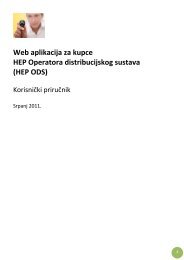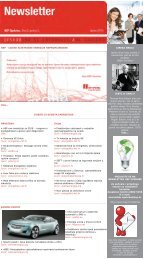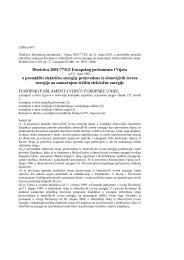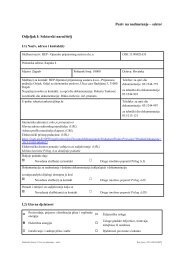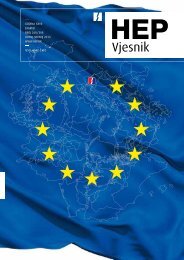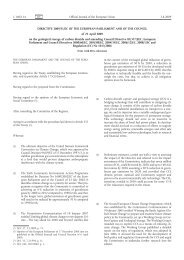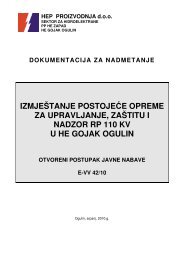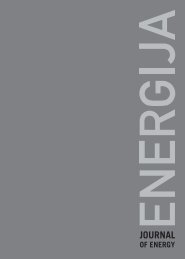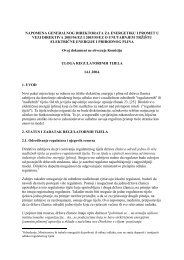Create successful ePaper yourself
Turn your PDF publications into a flip-book with our unique Google optimized e-Paper software.
jasno odrediti mjere koje kani poduzeti kako bi se<br />
postigao takav razvoj.<br />
Politika Europske unije je, dakle, ostavila mnogo<br />
slobode djelovanja dræavama Ëlanicama [6] kada je<br />
rijeË o izvorima koje treba razvijati (koji oËito variraju<br />
od zemlje do zemlje), kao i o instrumentima<br />
koje treba razviti, odnosno o konaËno zacrtanoj<br />
koliËini. Ipak, 1998. godine Komisija je donijela<br />
prvi nacrt prijedloga smjernice Europske unije<br />
glede pristupa obnovljivim izvorima energije na<br />
unutarnjem elektroenergetskom træiπtu. Tom se<br />
smjernicom utvrappleuju opÊenita naËela i globalni<br />
koliËinski ciljevi njihova razvoja.<br />
Iz analize prognoza koje su dane Bijelom knjigom<br />
(tablica 1) jasno se, meappleutim, razabire kako<br />
bi 3/4 ukupnog porasta proizvodnje elektriËne<br />
energije putem obnovljivih izvora energije trebalo<br />
dolaziti iz iskoriπtavanja biomase izraæeno u<br />
tonama ekvivalentne nafte (90 Mten od ukupno<br />
123 Mten). Analogno tome, poveÊanje doprinosa<br />
obnovljivih izvora energije u ukupnoj proizvodnji<br />
elektriËne energije trebalo bi prije svega biti<br />
posljedica sve veÊeg iskoriπtavanja biomase (oko<br />
200 TWh od 338 TWh), a isto tako bi trebao biti<br />
znaËajan i doprinos iskoriπtavanja energije vjetra.<br />
energy sources according to their potential. (...) It is<br />
important, therefore, that every member state determines<br />
its own strategy, and within it propose its own<br />
contribution to achieving the global goal by the year<br />
2010. The anticipated manner in which the various<br />
technologies would contribute to achieving the task<br />
should be stated. Moreover, each member state must<br />
clearly determine the measures it intends to undertake<br />
in order to achieve such development.<br />
The policy of the European Union, therefore, has left<br />
much freedom of activity to the member states [6]<br />
regarding the sources that should be developed (that<br />
obviously vary from country to country), as well as the<br />
instruments that have to be developed, i.e. the final<br />
determination of the quantity. Nonetheless, in 1998,<br />
the Commission adopted the first draft of the proposed<br />
guidelines of the European Union regarding the<br />
approach to renewable energy sources on the internal<br />
electrical energy market. These guidelines establish<br />
the general principles and global quantitative goals for<br />
their development.<br />
From analysis of the forecasts provided by the White<br />
Paper (Table 1), it can be clearly discerned that threequarters<br />
of the total growth of electrical energy via<br />
renewable energy sources should come from the use<br />
of biomass, expressed in million tons of oil equivalent<br />
(90 MTOE of the total 123 MTOE). Analogously, the<br />
increased contribution of renewable energy sources in<br />
the total production of electrical energy should be,<br />
first of all, the consequence of the ever increasing<br />
use of biomass (approximately 200 TWh of the total<br />
338 TWh). Similarly, the contribution to the production<br />
of electrical energy using wind energy should be<br />
significant.<br />
341<br />
De<br />
Paoli, L., ViπkoviÊ, A., Javna potpora razvitku obnovljivih..., Energija, god. 56(2007), br. 3., str. 328∑345<br />
De Paoli, L., ViπkoviÊ, A., Public support for the development..., Energija, vol. 56(2007), No. 3, pp. 328∑345



